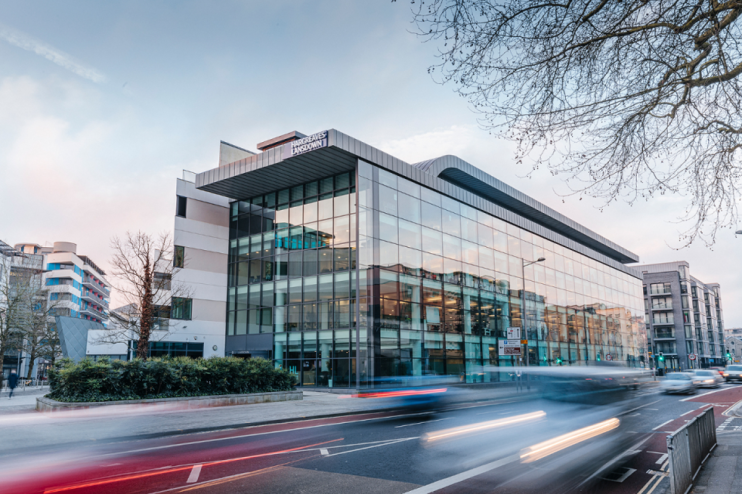Designing a Destination Workplace for a Leading Financial Services Firm
In today’s world of hybrid work, organisations face a critical question: how do you create a workplace that not only supports efficiency but also draws people in, builds culture, and provides an experience employees value? For a leading financial services company in Bristol, this question became central as they began planning the next chapter of their workplace.
The Challenge
The organisation’s workplace was functional but no longer fit for purpose in the post-pandemic world. Key challenges included:
- A workplace model still shaped around rows of desks, with limited variety in settings for collaboration, focus, and social interaction.
- A hybrid approach to working that lacked structure, creating unpredictability in how and when people used the office.
- A cultural attachment to fixed seating, despite a growing recognition that flexibility and shared spaces were needed.
- A lack of “destination” qualities that would make the workplace a compelling alternative to working from home.
- The need to ensure sustainability, efficiency, and employee experience were balanced in any future strategy.
In short, the workplace needed to evolve beyond being a container for people and desks. It had to become a space that supported productivity, innovation, and belonging — a true destination.
Our Approach
We applied an evidence-based, people-centred approach to workplace strategy, guided by four pillars: People, Place, Purpose, and Platforms.
- Engagement & Insights – We engaged with employees and leaders to understand how people worked, their expectations from the office, and the cultural factors shaping current behaviours. This ensured we went beyond assumptions and surfaced the underlying drivers of workplace use.
- Behavioural Patterns – Instead of focusing only on occupancy, we looked at patterns of behaviour — why people came into the office, what activities they prioritised, and what was missing from the experience.
- Workstyle Mapping – We identified a spectrum of workstyles across the business, from those who required dedicated spaces to those who were highly agile. This helped us understand how to balance predictability with flexibility in future workplace models.
- Scenario Thinking – We explored a range of high-level scenarios to show how different approaches to hybrid working and workplace design could impact space requirements, culture, and experience.
This holistic method allowed us to frame the future workplace as more than a real estate exercise — it became a strategic opportunity to reshape how people connect, collaborate, and perform.
Key Insights
Several insights emerged that shaped the future strategy:
- Variety Matters – Employees no longer want one-size-fits-all spaces. The future workplace must provide a balanced menu of environments for focus, collaboration, socialising, and wellbeing.
- Hybrid Drives Behaviour – In the absence of structure, people gravitate towards familiar patterns. Clear principles and supportive design are essential to make hybrid work effective.
- Culture is Critical – Without proactive change management, employees often view new models of desking or shared space as a downgrade. Success depends on engaging people early and positioning change as an upgrade in experience.
- Destination Effect – To compete with home working, the office must be more than functional. It needs to offer “pull” factors — community, culture, and experiences that can’t be replicated remotely.
- ESG & Efficiency – Sustainability goals and efficient space use must be embedded into strategy from the start, ensuring the workplace creates both business and environmental value.
From Insight to Strategy
Drawing on these insights, we developed a future workplace strategy built around four principles:
- Choice and Flexibility – Introducing a greater variety of settings to give employees choice in how they work, from focused zones to collaboration areas and social hubs.
- Destination Experience – Creating spaces that draw people in through hospitality-style amenities, informal collaboration zones, and design that fosters pride and belonging.
- Hybrid Enablement – Ensuring technology and space design fully support hybrid working, from video-enabled meeting rooms to quiet pods for virtual calls.
- Cultural Transition – Embedding change management as a central part of the journey, with pilots, champions, and communication designed to help employees adapt positively.
The Outcome
The strategy reframed the workplace as a destination, not a mandate. It gave the organisation a clear path to:
- Provide an environment that balances collaboration, focus, and wellbeing.
- Create a workplace culture where people want to be, not just where they need to be.
- Support hybrid work in a structured, sustainable, and engaging way.
- Align workplace investment with long-term business and environmental goals.
Most importantly, it shifted the conversation from “how many desks do we need” to “what role should the workplace play in our ecosystem of work?”
Why It Matters
This project highlights how the future of the workplace is not just about space efficiency but about creating value — for people, for business, and for society. By approaching the challenge through data, engagement, and strategic vision, the organisation can now build a workplace that is future-ready, resilient, and inspiring.




